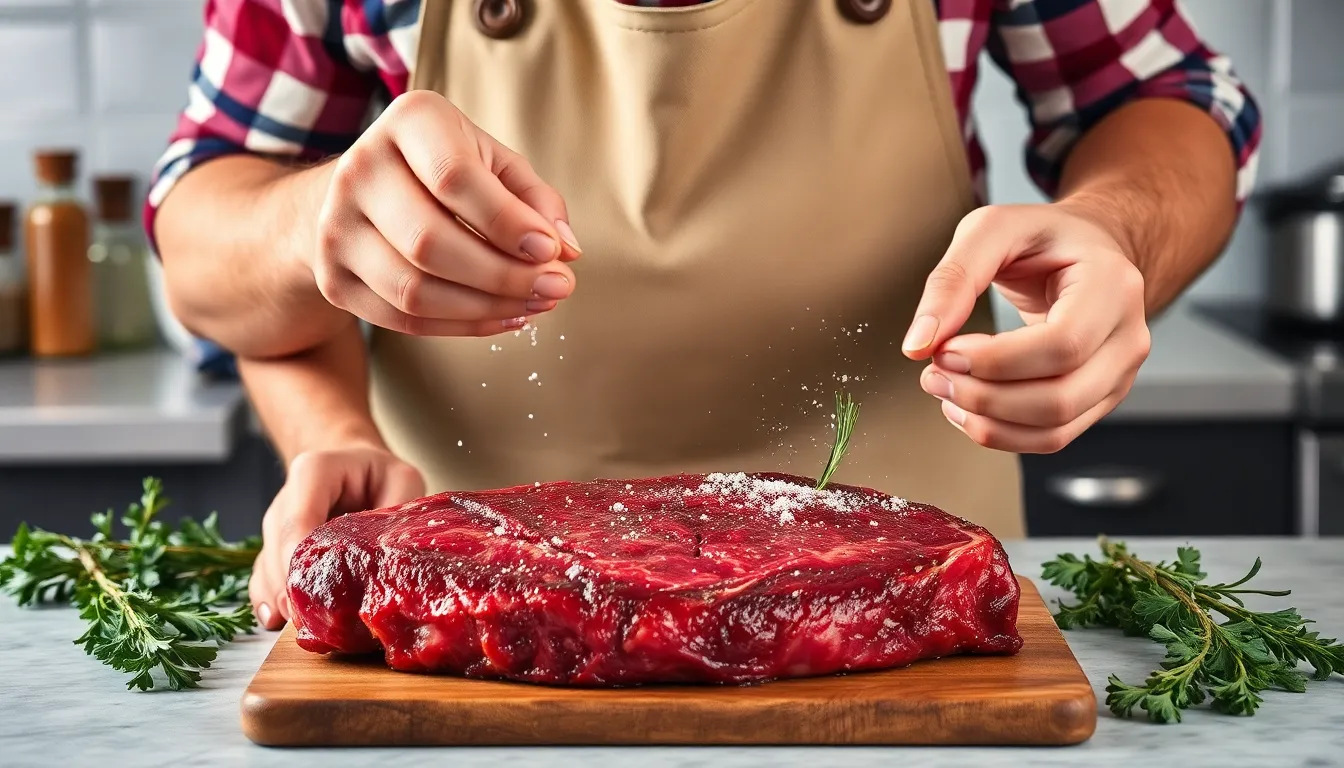Cooking steak on a cast iron skillet is like giving your taste buds a first-class ticket to flavor town. With its ability to retain heat and create that mouthwatering sear, cast iron isn’t just a cooking tool; it’s a culinary superhero. Imagine biting into a perfectly cooked steak that’s crispy on the outside and juicy on the inside. Sounds like a dream, right?
But wait—don’t let that dream turn into a nightmare! Mastering the art of steak cooking can seem intimidating, but it’s easier than you think. With a few simple tips and tricks, you’ll be flipping steaks like a pro in no time. So grab your skillet, roll up your sleeves, and get ready to impress your friends and family with a steak that’ll have them begging for seconds.
Table of Contents
ToggleWhy Choose Cast Iron For Cooking Steak
Cast iron skillets excel at retaining and distributing heat evenly. High temperatures create a perfect sear, sealing in juices for a tender steak. Durability defines cast iron; with proper care, it lasts for generations, becoming a family heirloom. Versatility adds to its appeal, as cast iron performs well on stovetops and in ovens.
A natural non-stick surface emerges over time, promoting healthy cooking with less oil. This feature allows for easy food release, simplifying the cleanup process. Flavor enhancement occurs through the skillet’s ability to develop a seasoned patina, enriching the steak’s taste.
Affordability factors into the decision; cast iron skillets are budget-friendly compared to other cookware. Maintenance involves simple techniques, ensuring its longevity and further enhancing cooking quality.
Many chefs endorse cast iron for its ability to withstand high heat, making it ideal for cooking techniques such as searing and baking. The heavy weight of the skillet contributes to stability on the burner, ensuring a consistent cooking surface.
Choosing cast iron for steak cooking provides heat retention, durability, versatility, and flavor enhancement. These advantages guarantee a satisfying cooking experience and delicious results.
Preparing The Steak

Preparing steak involves selecting the right cut and seasoning it properly. Both steps enhance the overall cooking experience.
Choosing The Right Cut
Selecting the right cut of steak is crucial for flavor and tenderness. Ribeye offers rich marbling, leading to juicy, flavorful bites. New York strip provides a nice balance of tenderness and texture. Filet mignon stands out for its buttery softness. Sirloin, though less fatty, remains a budget-friendly option with good taste. T-bone combines two cuts, offering both tenderness and flavor. Evaluate these cuts based on personal preferences, intended cooking methods, and budget before deciding.
Seasoning The Steak
Seasoning impacts the final taste of the steak significantly. A simple combination of salt and pepper enhances the natural flavors. Generously sprinkle kosher salt about 40 minutes before cooking to allow the meat to absorb the seasoning. Adding garlic powder or onion powder introduces extra depth. Fresh herbs like rosemary or thyme can elevate the flavor profile. For more complex flavors, consider dry rubs with spices such as paprika or cayenne. Allow steak to come to room temperature before cooking to ensure even seasoning throughout.
Cooking Techniques
Cooking techniques play a crucial role in achieving a perfectly cooked steak on a cast iron skillet. Mastery of these methods ensures outstanding flavor and texture, transforming an ordinary meal into an impressive feast.
Searing The Steak
Searing the steak creates a flavorful crust while locking in juices. Preheat the cast iron skillet over medium-high heat until it’s smoking hot. A high temperature triggers the Maillard reaction, essential for that enticing brown color and rich taste. Using high smoke point oil, like canola or avocado oil, further enhances this process. Place the steak in the skillet without overcrowding it. Allow it to sear undisturbed for 3 to 5 minutes, then flip and repeat. This method allows for optimal browning, rendering a crisp exterior that complements the tender inside.
Basting For Flavor
Basting enhances the steak’s flavor and juiciness. Once flipped, add unsalted butter and fresh herbs, such as thyme or rosemary, to the skillet. Tilt the pan slightly, allowing the melted butter to pool. Use a spoon to continually scoop the butter and pour it over the steak. This technique injects moisture while the aromatic herbs infuse additional depth. Basting typically takes about 2 to 3 minutes. The combined heat and seasoning create an exquisite flavor profile that elevates the entire dish, ensuring each bite is rich and satisfying.
Achieving The Perfect Doneness
Achieving the ideal doneness for steak can elevate the dining experience significantly.
Using A Meat Thermometer
Checking internal temperature ensures the steak reaches the desired doneness. Medium-rare, often preferred, has a target temperature of 130°F to 135°F. Alternatively, medium hits 140°F to 145°F while medium-well reaches 150°F to 155°F. A digital meat thermometer provides accuracy, helping prevent overcooking. Insert the thermometer into the thickest part of the steak, avoiding bones for an accurate reading. With practice, gauging doneness will become intuitive.
Resting The Steak
Resting the steak post-cooking lets juices redistribute for a more flavorful bite. Allowing five to ten minutes on a cutting board works well for most cuts. Covering loosely with foil retains warmth, preventing it from cooling too quickly. This step avoids a dry texture, ensuring every slice is juicy and tender. Enjoying the full flavor profile hinges on this small but essential timeframe.
Tips For Maintaining Your Cast Iron Skillet
Maintaining a cast iron skillet is vital for its longevity and performance. Regular seasoning creates a natural non-stick surface, enhancing cooking experience and flavor. After each use, wash the skillet with warm water and a soft sponge. Avoid soap, as it can strip away seasoning.
Dry the skillet immediately to prevent rust. Use a low heat on the stovetop to ensure it’s completely dry. Apply a thin layer of vegetable oil to the cooking surface after drying. This helps maintain seasoning and protects against moisture.
Storage matters in keeping cast iron in good condition. Place a paper towel inside the skillet to absorb moisture. Avoid stacking other cookware directly on top, which can scratch the surface.
Re-season the skillet when necessary. Signs include dull appearance or food sticking during cooking. To re-season, apply a generous coat of oil and bake it upside down in the oven at 450°F for an hour. This process helps restore the skillet’s non-stick qualities.
Do not forget about proper usage. Avoid cooking acidic foods regularly as they can damage seasoning. It’s also best to avoid drastic temperature changes, which can cause warping.
Seek advice from seasoned users for additional tips on care. Following these steps ensures the skillet remains a reliable tool for cooking steaks and other dishes for years to come.
Cooking steak on a cast iron skillet is a rewarding experience that can elevate any meal. The combination of heat retention and even cooking ensures a perfect sear while keeping the inside tender and juicy. With the right cut of steak and simple seasoning, anyone can impress their guests with a delicious dish.
Mastering techniques like basting and using a meat thermometer transforms the cooking process into an art form. Proper care and maintenance of the skillet not only enhance its performance but also ensure it serves as a kitchen staple for years. Embracing the versatility of cast iron opens up a world of culinary possibilities, making every steak night a memorable occasion.



